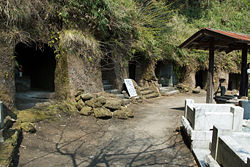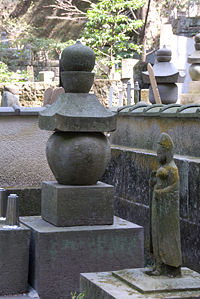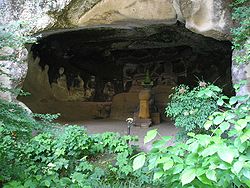
Yagura (tombs)
Encyclopedia

Kamakura, Kanagawa
is a city located in Kanagawa Prefecture, Japan, about south-south-west of Tokyo. It used to be also called .Although Kamakura proper is today rather small, it is often described in history books as a former de facto capital of Japan as the seat of the Shogunate and of the Regency during the...
, Kanagawa Prefecture
Kanagawa Prefecture
is a prefecture located in the southern Kantō region of Japan. The capital is Yokohama. Kanagawa is part of the Greater Tokyo Area.-History:The prefecture has some archaeological sites going back to the Jōmon period...
, Japan
Japan
Japan is an island nation in East Asia. Located in the Pacific Ocean, it lies to the east of the Sea of Japan, China, North Korea, South Korea and Russia, stretching from the Sea of Okhotsk in the north to the East China Sea and Taiwan in the south...
, as tombs and cenotaph
Cenotaph
A cenotaph is an "empty tomb" or a monument erected in honour of a person or group of people whose remains are elsewhere. It can also be the initial tomb for a person who has since been interred elsewhere. The word derives from the Greek κενοτάφιον = kenotaphion...
s. It is likely that they were used only as tombs in the beginning, and that later they started being used as cenotaphs too. The dead are usually samurai, but priests and even artisans have also been found (for example in the Hyakuhachi Yagura, see below). These tombs are extremely numerous in the hills surrounding Kamakura, and estimates of their number are in the thousands. Their real number must remain unknown, because many have already been destroyed and others surely haven't been found.
Yagura can be found either isolated, as in the case of the Harakiri Yagura (see below), or in groups of almost 200 hundred caves, as in the case of the group near , which includes 177 separate hand-made caves. Groups of yagura are labeled with the suffix as in the case of the Hyakuhachi Yagura Group mentioned above. The easiest way to see a yagura is to visit Jufuku-ji
Jufuku-ji
, usually known as Jufuku-ji, is a temple of the Kenchō-ji branch of the Rinzai sect and the oldest Zen temple in Kamakura, Kanagawa Prefecture, Japan. Ranked third among Kamakura's prestigious Five Mountains, it is number 24 among the pilgrimage temples and number 18 of the temples...
near Kamakura station
Kamakura Station
is a railway station in Kamakura, Kanagawa, Japan, operated by East Japan Railway Company .-Lines:Kamakura Station is served by the Yokosuka Line and Shōnan-Shinjuku Line. It is located 4.5 km from the junction at Ōfuna Station, and 53.9 km from Tokyo Station...
: its cemetery has many (see photo), among them Hōjō Masako
Hojo Masako
was the eldest child of Hōjō Tokimasa by his wife Hōjō no Maki, the first shikken, or regent, of the Kamakura shogunate. She was the sister of Hōjō Yoshitoki, and was married to Minamoto no Yoritomo, the first shogun of the Kamakura period...
's and Minamoto no Sanetomo
Minamoto no Sanetomo
Minamoto no Sanetomo was the third shogun of the Kamakura shogunate Sanetomo was the second son of the founder of the Kamakura shogunate Minamoto no Yoritomo, his mother was Hōjō Masako, and his older brother was the second Kamakura shogun Minamoto no Yoriie.His childhood name was...
's cenotaphs.
True yagura can be found also in the Miura Peninsula
Miura Peninsula
is a peninsula located in Kanagawa, Japan. It lies south of Yokohama and Tokyo and divides Tokyo Bay, to the east, from Sagami Bay, to the west. Cities and towns on the Miura Peninsula include Yokosuka, Miura, Hayama, Zushi, and Kamakura....
, in the Izu Peninsula
Izu Peninsula
The is a large mountainous peninsula with deeply indented coasts to the west of Tokyo on the Pacific coast of the island of Honshū, Japan. Formerly the eponymous Izu Province, Izu peninsula is now a part of Shizuoka Prefecture...
, and even in distant Awa Province (Chiba)
Awa Province (Chiba)
was a province of Japan in the area of modern Chiba Prefecture. It lies on the tip of the Boso Peninsula , whose name takes its first kanji from the name of Awa Province and its second from Kazusa and Shimōsa Provinces. Its abbreviated form name was or...
.
History
Because of lack of solid documentary or archeological evidence, in spite of their recent origin not much is known about Kamakura's yagura, and some of what is known is contradictory.For example, the exact time and reason for the adoption of the yagura system are unknown. It is however generally believed that tombs were dug in the soft rock of the hills around the city because of lack of space in the valley below.
The only way to date a yagura is through the dates carved on a gorintō
Gorinto
is the name of a Japanese type of Buddhist pagoda believed to have been first adopted by the Shingon and Tendai sects during the mid Heian period. It is used for memorial or funerary purposes and is therefore common in Buddhist temples and cemeteries. It is also called or , where the term sotoba...
or stele it may contain. On this basis, the oldest was one found near the Asahina Pass
Kamakura's Seven Entrances
The city of Kamakura, Kanagawa in Japan, is closed off on three sides by very steep hills and on the fourth by the sea: before the construction of several modern tunnels and roads, the so-called Seven Entrances , or were its main links to the rest of the world...
and dated to between 1260 and 1270. It used to be thought that a particular law with an ambiguous name which forbids cemeteries in towns (the ) referred to Kamakura, and therefore was the origin of the custom, but now it is believed to have been written by Bungo
Bungo Province
was a province of Japan in eastern Kyūshū in the area of Ōita Prefecture. It was sometimes called , with Buzen Province. Bungo bordered Buzen, Hyūga, Higo, Chikugo, and Chikuzen Provinces.-History:...
's Ōtomo clan
Otomo clan
The Ōtomo clan was a Japanese clan whose power stretched from the Kamakura period through the Sengoku period, spanning over 400 years. The clan's hereditary lands lay in Kyūshū....
in Kyūshū
Kyushu
is the third largest island of Japan and most southwesterly of its four main islands. Its alternate ancient names include , , and . The historical regional name is referred to Kyushu and its surrounding islands....
for its city of Fuchū. However, some historians think the Ōtomo must have used a Kamakura shogunate
Kamakura shogunate
The Kamakura shogunate was a military dictatorship in Japan headed by the shoguns from 1185 to 1333. It was based in Kamakura. The Kamakura period draws its name from the capital of the shogunate...
law as a model. The custom continued after the demise of the shogunate and well into the Ashikaga period
Ashikaga shogunate
The , also known as the , was a Japanese feudal military regime, ruled by the shoguns of the Ashikaga clan.This period is also known as the Muromachi period and gets its name from Muromachi Street of Kyoto where the third shogun Ashikaga Yoshimitsu established his residence...
until the middle of the 15th century, after which it declined. The yagura of the time give some indication of the decline of the custom: some have been converted to storehouses, others were filled with soil to bury in them a corpse.
Structure of a yagura

In many cases the sendō of a yagura had at its mouth a wooden door, whose remains can sometimes still be seen. The bones are in some cases collected in an opening in the floor, but in other tombs there is instead a funerary urn. In either case, yagura floors are made of rock, so by nature aren't suitable to burials, therefore the remains must have been cremated before inumation. In fact, pulverized bones bearing traces of a cremation are still occasionally found.
Inside a yagura can usually be found some non-personal objects. Often present are for example stone gorintō (see photo), steles or hōkyōintō
Hokyointo
A is a Japanese pagoda, so called because it originally contained the sūtra. A Chinese varianto of the Indian stūpa, it was originally conceived as a cenotaph of the King of Wuyue - Qian Liu.- Structure and function :...
(Buddhist towers), all of which are always later additions. There can also be Buddha images and statues of Jizō. On the ceiling of the are visible red painted rafters.
Etymology and writing of the name
As many other aspects of yagura and their history, the etymology of the name is unclear. According to a theory, the name derives from , or watchtower, but it seems more likely that it is just a local corruption of , that is, a stone storehouse..The word yagura over the centuries has been written in several ways, among them , etc.. We do know that in the Edo period
Edo period
The , or , is a division of Japanese history which was ruled by the shoguns of the Tokugawa family, running from 1603 to 1868. The political entity of this period was the Tokugawa shogunate....
the character was pronounced yagura. In any case, now the term is usually written in hiragana without using Chinese characters.
Famous yagura in Kamakura

- Otō no Kubo - One of the yagura supposed to be Hōjō TakatokiHojo TakatokiHōjō Takatoki was the last Tokuso and ruling Shikken of Japan's Kamakura shogunate; the latter ones were his puppets, a member of the Hōjō clan, he was the son of Hōjō Sadatoki, and was preceded as shikken by Hōjō Morotoki.Takatoki became regent at the age of eight, and thus actual power was...
's grave. - Karaito Yagura - Close to the Shakadō Pass. Due to the remains of a wooden door which are still visible today, legend says it was a prison.
- Jitsugetsu Yagura - Also close to the Shakadō Pass. The name comes from the two openings in the wall shaped like the sun and the moon.
- Kubi Yagura - Behind Zuisen-jiZuisen-jiis a Buddhist temple of the Rinzai sect in Nikaidō's near Kamakura, Japan. During the Muromachi period it was the family temple of the Ashikaga rulers of Kamakura : four of the five kubō are buried there in a private cemetery closed to the public and first kubō Ashikaga Motouji's is also known...
, this is another supposed grave of Hōjō Takatoki. - Shakadō Yagura Group - This is supposed by tradition to be the burial place of those who died at Tōshō-jiTosho-jiwas the Hōjō clan's family temple in Kamakura during the Kamakura period. Its founder was Taikō Gyōyū and it was constructed in 1237 by Hōjō Yasutoki in memory of his mother, who had her tomb there. According to the Taiheiki, from its foundation until the end of the Kamakura shogunate every regent...
at the fall of the Kamakura shogunateKamakura shogunateThe Kamakura shogunate was a military dictatorship in Japan headed by the shoguns from 1185 to 1333. It was based in Kamakura. The Kamakura period draws its name from the capital of the shogunate...
in 1333 . It has been partly destroyed by urban development. - Shutarugi Yagura - In the mountains near Nishi MikadoNishi Mikadois the name of a neighborhood in Kamakura, a city located in Kanagawa, Japan, about 50 km south-south-west of Tokyo. Nishi Mikado lies north-east of Tsurugaoka Hachiman-gū.- Etymology of the name:...
. - Harakiri Yagura - Near the ruins of Tōshō-jiTosho-jiwas the Hōjō clan's family temple in Kamakura during the Kamakura period. Its founder was Taikō Gyōyū and it was constructed in 1237 by Hōjō Yasutoki in memory of his mother, who had her tomb there. According to the Taiheiki, from its foundation until the end of the Kamakura shogunate every regent...
in Komachi 3-chōme. This is supposed to be the place where Hōjō TakatokiHojo TakatokiHōjō Takatoki was the last Tokuso and ruling Shikken of Japan's Kamakura shogunate; the latter ones were his puppets, a member of the Hōjō clan, he was the son of Hōjō Sadatoki, and was preceded as shikken by Hōjō Morotoki.Takatoki became regent at the age of eight, and thus actual power was...
killed himself at the fall of the shogunate. - Tahō-ji-ato Yagura - In the woods near Ōgigayatsu. Nearby there's a huge gorintō called . - At the bottom of the Urigayatsu Valley. - In the Higashi Sensui valley.
- Hyakuhachi Yagura - Located near Kakuon-ji, it contains 177 yagura. It contains all known types of yagura.
- Jushi Yagura - In the Nishi Urigayatsu Valley. Contains the reliefs of 14 gorintō.
- Mandaladō Group - Kamakura period yagura group located to the north of the Nagoshi Pass and containing 104 graves. It used to be called but started to be called to distinguish it from the Sarubatake Yagura behind Hosshō-ji. The name indicates that in the area there used to be a temple dedicated to memorial services for the dead (a kuyōdo). Divided in three groups, it is built in a flat area carved up from an artificial cliff built to defend the Nagoshi PassKamakura's Seven EntrancesThe city of Kamakura, Kanagawa in Japan, is closed off on three sides by very steep hills and on the fourth by the sea: before the construction of several modern tunnels and roads, the so-called Seven Entrances , or were its main links to the rest of the world...
. It contains both Kamakura and Muromachi period graves.
External links
Further information and photos of yagura are available at the following sites.- Castle Japan - Yagura accessed on July 31, 2008
- Karaito Yagura and the Jitsugetsu Yagura accessed on July 31, 2008
- The Hōjōkubi Yagura accessed on July 31, 2008
- The Hōjō Takatoki Harakiri Yagura accessed on July 31, 2008
- The Kōyōyama Yagura accessed on July 31, 2008
- The Shutarugi Yagura accessed on July 31, 2008
- The Hyakuhachi Yagura accessed on July 31, 2008
- The Otō no Kubo Yagura accessed on July 31, 2008
- The Hōjō Kubi Yagura accessed on July 31, 2008
- The Urigayatsu Yagura accessed on July 31, 2008
- The Higashi Sensui Yagura accessed on July 31, 2008
- The Hōjō Takatoki Harakiri Yagura accessed on July 31, 2008

